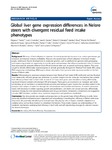Por favor, use este identificador para citar o enlazar este ítem:
http://www.alice.cnptia.embrapa.br/alice/handle/doc/1034697| Título: | Global liver gene expression differences in Nelore steers with divergent residual feed intake phenotypes. |
| Autor: | TIZIOTO, P.  COUTINHO, L. L.   DECKER, J. E.   SCHNABEL, R. D.   ROSA, C. O.   OLIVEIRA, P. S. N.   SOUZA, M. M.   MOURÃO, G. B.   TULLIO, R. R.   CHAVES, A. S.   LANNA, D. P. D.   ZERLOTINI NETO, A.   MUDADU, M. A.   TAYLOR, J. F.   REGITANO, L. C. A.   |
| Afiliación: | POLYANA TIZIOTO, CPPSE, University of Missouri Columbia; LUIZ L. COUTINHO, Esalq/USP; JARED E. DECKER, University of Missouri Columbia; ROBERT D. SCHNABEL, University of Missouri Columbia; KAMILA O. ROSA, Unesp Jaboticabal; PRISCILA S. N. OLIVEIRA, UFSCar; MARCELA M. SOUZA, UFSCar; GERSON B. MOURÃO, Esalq/USP; RYMER RAMIZ TULLIO, CPPSE; AMÁLIA S. CHAVES, Esalq/USP; DANTE P. D. LANNA, Esalq/USP; ADHEMAR ZERLOTINI NETO, CNPTIA; MAURICIO DE ALVARENGA MUDADU, CPPSE; JEREMY F. TAYLOR, University of Missouri Columbia; LUCIANA CORREIA DE ALMEIDA REGITANO, CPPSE. |
| Año: | 2015 |
| Referencia: | BMC Genomics, London, v. 16, p. 1-14, 2015. |
| Descripción: | Background: Efficiency of feed utilization is important for animal production because it can reduce greenhouse gas emissions and improve industry profitability. However, the genetic basis of feed utilization in livestock remains poorly understood. Recent developments in molecular genetics, such as platforms for genome-wide genotyping and sequencing, provide an opportunity to identify genes and pathways that influence production traits. It is known that transcriptional networks influence feed efficiency-related traits such as growth and energy balance. This study sought to identify differentially expressed genes in animals genetically divergent for Residual Feed Intake (RFI), using RNA sequencing methodology (RNA-seq) to obtain information from genome-wide expression profiles in the liver tissues of Nelore cattle. Results: Differential gene expression analysis between high Residual Feed Intake (HRFI, inefficient) and low Residual Feed Intake (LRFI, efficient) groups was performed to provide insights into the molecular mechanisms that underlie feed efficiency-related traits in beef cattle. A total of 112 annotated genes were identified as being differentially expressed between animals with divergent RFI phenotypes. These genes are involved in ion transport and metal ion binding; act as membrane or transmembrane proteins; and belong to gene clusters that are likely related to the transport and catalysis of molecules through the cell membrane and essential mechanisms of nutrient absorption. Genes with functions in cellular signaling, growth and proliferation, cell death and survival were also differentially expressed. Among the over-represented pathways were drug or xenobiotic metabolism, complement and coagulation cascades, NRF2-mediated oxidative stress, melatonin degradation and glutathione metabolism. Conclusions: Our data provide new insights and perspectives on the genetic basis of feed efficiency in cattle. Some previously identified mechanisms were supported and new pathways controlling feed efficiency in Nelore cattle were discovered. We potentially identified genes and pathways that play key roles in hepatic metabolic adaptations to oxidative stress such as those involved in antioxidant mechanisms. These results improve our understanding of the metabolic mechanisms underlying feed efficiency in beef cattle and will help develop strategies for selection towards the desired phenotype. |
| Thesagro: | Bos Indicus |
| NAL Thesaurus: | Zebu Feed conversion Transcriptomics Bioinformatics |
| Palabras clave: | Transcriptoma Sequenciamento genético Bioinformática RFI Feed efficiency |
| DOI: | DOI 10.1186/s12864-015-1464-x |
| Tipo de Material: | Artigo de periódico |
| Acceso: | openAccess |
| Aparece en las colecciones: | Artigo em periódico indexado (CNPTIA)  |
Ficheros en este ítem:
| Fichero | Descripción | Tamaño | Formato | |
|---|---|---|---|---|
| GloballiverTizioto.pdf | 1,4 MB | Adobe PDF |  Visualizar/Abrir |









